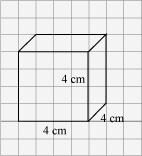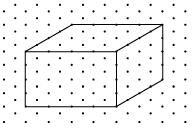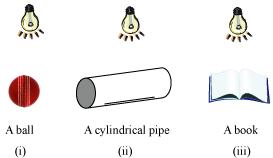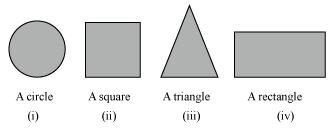Visualizing Solid Shapes
Give (i) an oblique sketch and (ii) an isometric sketch for each of the following:
(a) A cuboid of dimensions 5 cm, 3 cm and 2 cm. (Is your sketch unique?)
(b) A cube with an edge 4 cm long.
(i) Oblique sketch

(ii) Isometric sketch


The sketch for the cuboid is not unique. The cuboid can also be drawn by taking the length as 3 cm or 2 cm. This will lead to a different view of the same cuboid.
Sponsor Area
Some More Questions From Visualizing Solid Shapes Chapter
Make an oblique sketch for each one of the given isometric shapes:

Give (i) an oblique sketch and (ii) an isometric sketch for each of the following:
(a) A cuboid of dimensions 5 cm, 3 cm and 2 cm. (Is your sketch unique?)
(b) A cube with an edge 4 cm long.
What cross-sections do you get when you give a
(i) vertical cut (ii) horizontal cut
to the following solids?
(a) A brick (b) A round apple (c) A die
(d) A circular pipe (e) An ice cream cone
A bulb is kept burning just right above the following solids. Name the shape of the shadows obtained in each case. Attempt to give a rough sketch of the shadow. (You may try to experiment first and then answer these questions).

Here are the shadows of some 3−D objects, when seen under the lamp of an overhead projector. Identify the solids (s) that match each shadow. (There may be multiple answers for these!)

Examine if the following are true statements:
(i) The cube can cast a shadow in the shape of a rectangle.
(ii) The cube can cast a shadow in the shape of a hexagon.
Mock Test Series
Sponsor Area
NCERT Book Store
NCERT Sample Papers
Sponsor Area